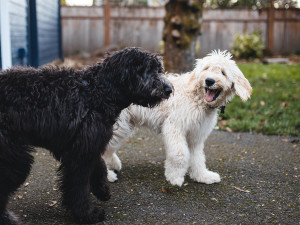Do Dogs Share Food?
Study says dogs do share and they’re more generous with those they know.

Share Article
Your dogs might not seem to share at home but dogs can share food, well sometimes. A study of sharing behaviors in dogs found many things influence whether dogs choose to give food to other dogs or not. Researchers investigated “prosocial” behavior in dogsopens in new tab — voluntary behavior that benefits others — aka sharing and found some interesting results.
Sharing in Dogs
In the study, dogs were trained to touch a token with their nose to deliver food to another dog in a nearby enclosure or touch another token where nothing happened.
During the experiment, the dog in the enclosure was periodically swapped. So, sometimes the enclosure contained a roommate of the dog being tested with the tokens; other times, it was an unfamiliar dog; and occasionally, it was empty. In some trials, a third dog was next to the dog being tested when they were choosing whether to touch the token to give food away. Sometimes they were alone when making their choice.
Why Do Dogs Share?
Researchers found that dogs were more likely to share food in certain circumstances.
How much do you spend on your pet per year?

Dogs were more likely to give food to dogs who they live with than to dogs who are strangers.
Having another dog with them made them more generous, meaning that they were more likely to give food when they were with another dog rather than when they were alone.
To be fair, the dogs were not literally sharing the food out of their own bowl. (Food aggression is a real problem with some dogs.) They were choosing to act so that food would be given to another dog, but they didn’t lose out on any food by providing food to the other dog. Still, it’s nice to know that dogs can share food, even if what we most appreciate about them is their ability to share love.

Karen B. London, PhD, CAAB, CPDT-KA
Karen B. London is a certified applied animal behaviorist (CAAB) and certified professional dog trainer (CPDT) who specializes in working with dogs with serious behavioral issues, including aggression. She has written for a variety of magazines including The Bark, Clean Run, and the APDT Chronicle of the Dog, and has published in scientific journals including Behavioral Ecology and Sociobiology, Ethology, Ecology, and Evolution, the Journal of Insect Behavior, and Insectes Sociaux. She is the author of seven books about dog training and canine behavior, including the forthcoming My Dog's Mystery Adventure: And Other Stories From a Canine Behaviorist and Dog Trainer.
Related articles
![Dog laying on the ground guarding toy in mouth]()
How to Get Your Dog to Stop Resource Guarding Their Stuff
If your dog growls when you get near their food or toys, read this right now.
![Couple hugs their merle Boxer]()
How to Improve Your Relationship with Your Dog
Animal behaviorist Dr. Karen B. London on how to strengthen your pet-parent bond.
![A woman walking 5 dogs on leashes outside.]()
Breed Does Not Equal Behavior—Here’s Why
A new study found that a dog’s breed accounts for less than 10 percent of their behavior.
![A person giving a banana to a dog.]()
10 Fruits and Vegetables That Your Dog Can Feast On
Indulge your pup (safely) with these delicious and healthy snacks.




